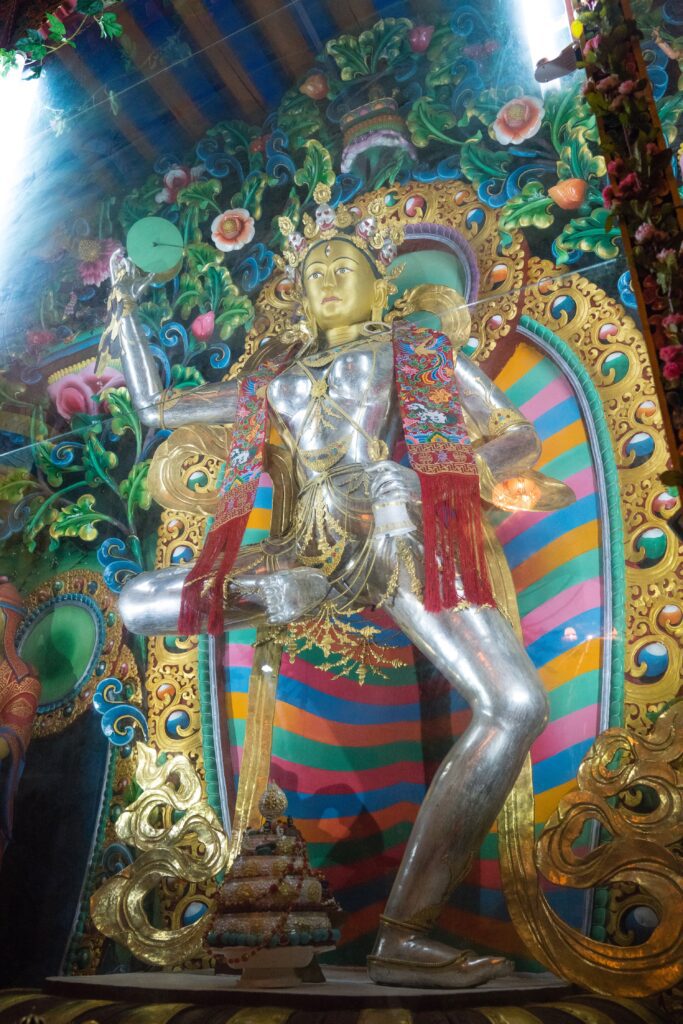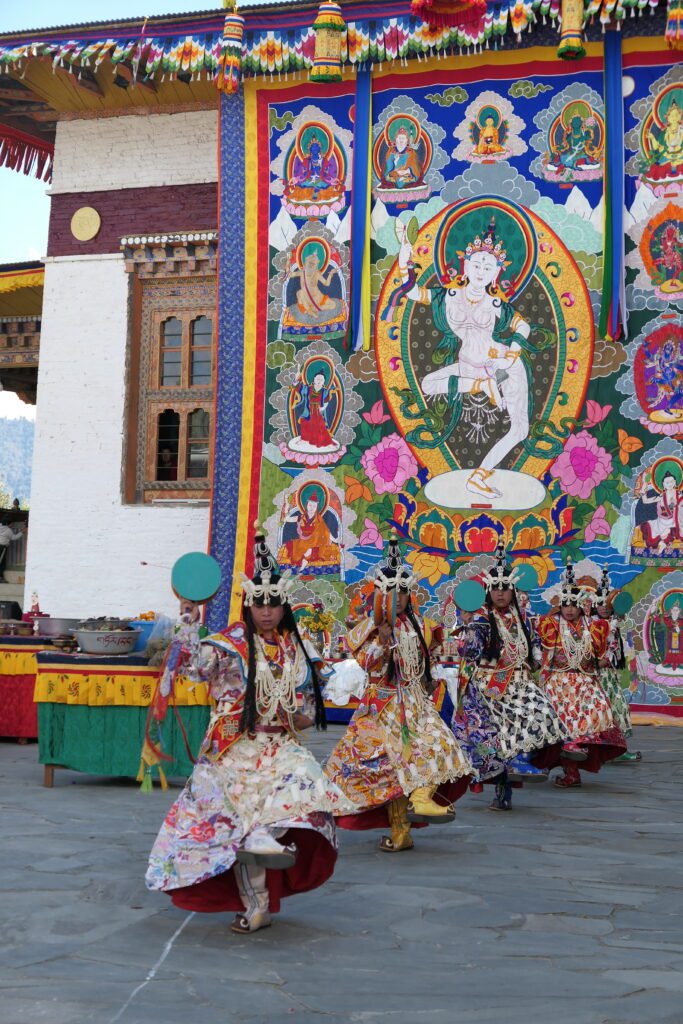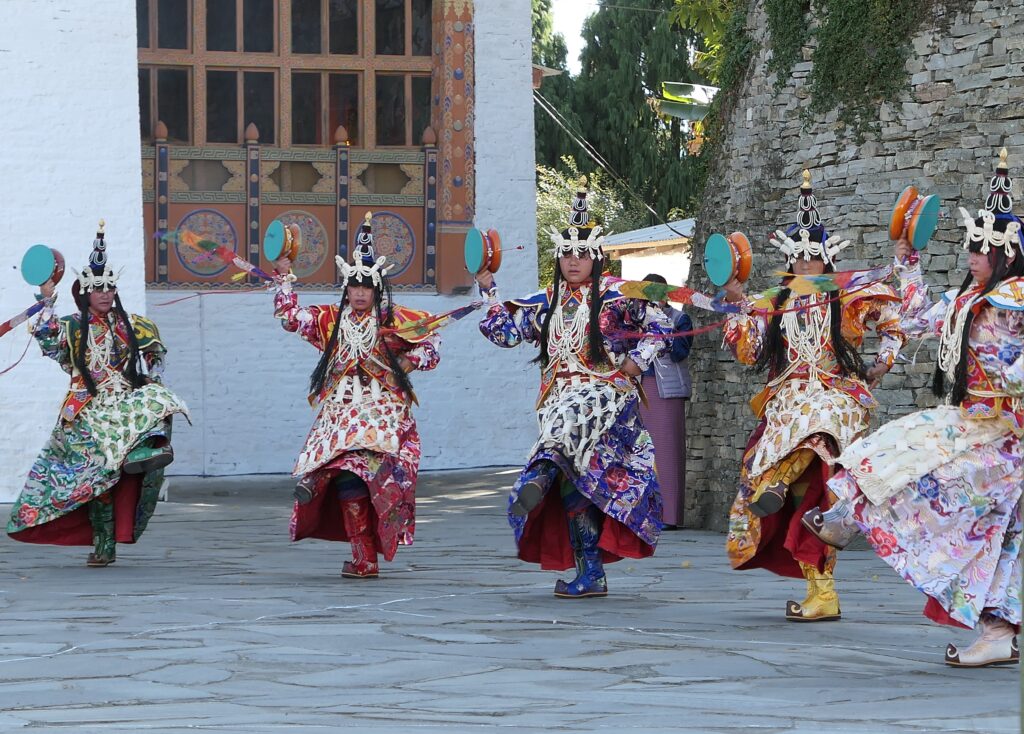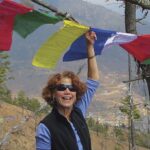In the northeastern reaches of Bhutan, situated in the center of a cup-shaped formation of mountains surrounding a valley, located in Rawabi Village, Lhuentse District, sits a settlement called Druk Zangri Khamar. There, a community of lay and monastic Vajrayana practitioners continues the lineage practices of the 11th-century yogini and female Tibetan lama, Machig Labdrön. In stark contrast to other religious communities in Bhutan, where women still sit in the back of the prayer halls, the gomchemas, female lay practitioners (gomchen(m)/gomchenma(f) mean “great meditator” and refer to non-monastic, lay practitioners) of Druk Zangri Khamar sit in the front row and co-lead the practices. Not only that but despite the long-held custom of male practitioners exclusively performing the sacred cham (Vajrayana ritual dances), here, the gomchenma perform the Dakini Chöd Cham. The dance is an essential element of the jinsek, or fire offering ritual, performed every year to overcome negative energy, purify the collective karma, and benefit the community.
Today’s residents of Druk Zangri Khamar, are Bhutanese as well as descendants of a group of thirty Tibetan emigrés who made a prophetic exodus to Bhutan in 1952 to safeguard their spiritual heritage from the destruction that would soon befall Tibetan sovereignty, culture, and religious life during the Chinese Cultural Revolution. The Tibetans came from Zangri Khamar ─ the seat of Machig Labdrön, who formulated the chöd practice as a method to integrate the Buddha’s teachings on emptiness as set forth in the Prajnaparamita (Perfection of Transcendent Wisdom) Sutras. Here, emptiness refers to all phenomena as being “empty” of inherent existence ─ existing only relationally as a result of an endless stream of causes and conditions.
The practice of chöd, meaning “severance,” is a meditative visualization supported by chanting a liturgy, playing the chöd instruments (double-sided drum, bell, and thighbone trumpet), and sometimes performing ritual dances to cut through and dismantle our dualistic concepts. Through the visualized offering of one’s own body as a banquet to one’s sources of refuge, one’s obstructors, and even the most reviled enemies, one whittles away at inner obstacles and severs attachment to the idea of self as distinct from other. This radical process is intended to merge the offeror and recipients in a state of equality.
The Tibetans that arrived in Bhutan from Zangri Khamar came bearing sacred relics on their backs and the earliest known lineage traditions of Machig Labdrön in their bodies, hearts, and minds. Their leader was the treasure revealer Trülshik Rigdzin Lingpa. During meditation, he had a vision where he was directed to relocate the community to a place shaped like a fully blossomed lotus in a land ruled by a dharma king, by the dakinis. The Sanskrit word dakini (khandroma in Tibetan) is sometimes translated as “sky-dancer.” A dakini is a female wisdom being who instigates spiritual growth through her understanding of emptiness. She is usually depicted iconographically as dancing because of her dynamic qualities and spacious ease. This prescient advice proved to save the treasures and traditions of Machig Labdrön’s lineage. Fortunately, Trülshik Rigdzin Lingpa had a disciple from Bhutan, Togden Tsewang Choepel, who facilitated the community’s relocation. Tsewang Choepel applied to the governor of his home district for permission to grant the Tibetans a portion of his family’s ancestral land. Once in Bhutan ─ or Druk Yul, as Bhutan is often called, meaning Land of the Thunder Dragon — the community was renamed Druk Zangri Khamar.
Shortly after the escape from Tibet, Trülshik Rigdzin Lingpa passed away. The settlement of lay practitioners came under the leadership of Togden Tsewang Choepel and, thereafter, his son, the current lama, Rigdzin Longyang Rinpoche. Under Rigdzin Longyang Rinpoche, who was recognized as the reincarnation of his father’s teacher, Trülshik Rigdzin Lingpa, the community has flourished and continues to this day.
In 2015 Rinpoche commissioned and later consecrated an exquisite new temple filled with colorful textiles, vivid murals, and impressive statuary dedicated to Machig Labdrön, her lineage, and the divine feminine. In fact, the crowning glory of the temple’s shrine room is a five-meter-tall, larger-than-life statue of Machig Labdrön. She stands shimmering in the light ─ naked and dancing! Her silver body is adorned with delicate gold-tone bone ornaments, and her golden face is topped with a regal crown of skulls sprouting golden petal-like flames. Dancing with her bell and damaru (drum), she is extraordinary.

During the same year, the community opened a small monastery, drawing a cohort of monastic students and dynamic teachers, who energize and enliven day-to-day life and the collective’s calendar of events.
I arrived at this remote outpost in 2023 as part of a pilgrimage from Tara Mandala, the international Buddhist organization and retreat center (in Colorado) founded by the Western female lama, Tsultrim Allione. Lama Tsultrim, as she is called, is an outspoken teacher, writer, and champion of the sacred feminine. A well-known teacher of Machig Labdrön’s philosophy and chöd practice and recognized by lineage lamas from Tibet, Nepal, and Bhutan as an emanation of Machig Labdrön, Lama Tsultrim made an initial trip along with sixty of her students to Druk Zangri Khamar in 2017. The interconnection between the two communities was immediate ─ due, in large part, to the intersection of their leaders’ aspirations. Lama Rigdzin Longyang Rinpoche is deeply concerned that his community’s lineage traditions continue despite the inaccessibility of his remote locale to new students. In fact, most Bhutanese have never heard of Druk Zangri Khamar, much less made the arduous, 12-hour drive from the center of the country up the winding mountain roads to the far-off village. Lama Tsultrim Allione, in her dedication to the sacred feminine, wants to institute this lineage and its practices in the West, where she hopes they will grow and spread.
As part of a much smaller second wave of pilgrims from Tara Mandala, I traveled to Druk Zangri Khamar in 2023 and again in 2024. We were tasked with learning the Rinchen Trengwa Chöd (Jewel Garland Chöd), a compendium of Machig Labdrön’s oldest and most essential teachings as compiled by the Third Karmapa, Je Rangjung Dorje (1284-1339). This involved learning the liturgy and some thirty original chöd melodies and drumming unique to the lineage, the ritual activity, and the sacred dances. The dances are what beckoned me on this journey. I had wanted to learn the sacred cham since first seeing them in Bhutan in 2011. At that time, it was unthinkable for a woman — much less a foreign woman — to receive these teachings and participate in this level of sacred activity. I had observed, researched, and written about cham for years ─ all the while longing to dance them and experience their spiritual dimensions.
At the jinsek held as part of the community’s annual drupchen (consecration ceremony), the gomchenma performed the Dakini Chöd Cham daily for three consecutive days. The cham is performed outdoors in the spacious temple courtyard around the jinsek fire and tables arranged with ingredients prepared for the ritual. Jinsek is a practice of offering substances into a ritual fire, using the fire element to expedite a quick and powerful delivery of the offerings to the divine realm. Its purpose is to accomplish the four ritual-activities: pacification of negative conditions, increasing of positive factors, magnetizing control over circumstances, and destruction of hostile forces. The cham is performed during the jinsek to facilitate these ritual activities.

On the final day of the drupchen, the magnificent thongdrol (giant-sized religious painting on fabric) of Machig Labdrön is hoisted outdoors against the façade of the temple. Machig’s white, dancing figure is surrounded by a refuge field of her lineage. The tapestry design was envisioned by Rigdzin Longyang Rinpoche, completed by an artist in the capital city of Thimphu, and consecrated in 2019. Such artistic representations are used as a support for accurate visualization during ritual and meditation practices. As a sacred and consecrated work of art, it also functions as a blessing multiplier on such an auspicious day. The Tibetan word thongdrol means “liberation upon sight,” and that is exactly what it is meant to do ─ hasten everyone who looks upon it toward spiritual awakening, not one being left behind.
The jinsek ritual began in the temple courtyard with the mesmerizing prayer “Evocation of the Dakini.” This soulful chant, with its verses of supplication and the insistent beat of the chöd instruments, frequently elicits a spontaneous display of devotional prostrations from members of the community. This chorus of movement augments the building drama of the ritual. The thongdrol eventually becomes the stunning backdrop for the Dakini Chöd Cham. Moreover, cham is also considered thongdrol ─ capable of liberating upon sight.
[Watch a short clip of a Cham performance from the Jinsek in Bhutan. Video by Karen Greenspan.]
The cham is a dance for five dakinis, who each represent one of the five wisdom families (Vajra, Ratna, Padma, Karma, and Buddha) in the mandala. The costume design, hand-held implements, and dance movements adhere to the description of Machig Labdrön and her dakini entourage stated in the chöd text:
She is standing in a dancing posture, with her left leg extended downward and her right foot contracted upward. In her right hand she is holding a large damaru or hand drum, made out of gold, which she holds aloft in space. In her left hand she is holding a silver bell, which is resting gracefully on her left hip. Most of her hair is bound up in a topknot and the rest of it flows freely down her back.
Her naked body is adorned with the six bone ornaments (jewelry made of threaded pieces of real bone), which represent her attainment of the six paramitas or transcendent perfections:
- Bone wheel, which sits on top of her head and represents the perfection or paramita of jnana (wisdom).
- Bone necklace, which represents the perfection of generosity.
- Bone bracelets, which are at the wrists, above the elbows, and at the ankles, which represent the perfection of morality.
- Bone earrings represent the perfection of patience.
- Bone belt or apron, with bones hanging from it, which represents the perfection of diligence.
- Elegant wheels of carved bone, on the front and on the back that are held together by garlands of bone and form an “x” across the torso.
Obviously, these dakinis live in contemporary times and are clothed. They wear sumptuous brocade robes in the five elemental colors (white, yellow, dark blue, green, and red) and are bedecked with bone ornaments. Each color is associated with one of the five wisdom/buddha families and symbolizes that each dakini has transmuted an obstructive emotion into an aspect of enlightenment. Every detail of the dakinis’ attire is encoded with sacred cues for the performer as well as for the viewer. The process of donning and securing these elaborate costumes always requires assistance. In a new and lovely “tradition,” quite distinct to this community where the dancers are married practitioners, the women’s husbands assist them in putting on the dakini attire.
The dancers carry and play the chöd instruments while dancing a moving mandala in the ritual space. The mandala, as a representation of a pure land — an ideal world — serves as a metaphorical space for transformation. The five dakinis are agents of that transformation. The iconography typically found in artistically rendered mandalas is created with steps and floor patterns (e.g., the chain of vajras that forms a protective boundary, the purifying outer rim of flames). Interspersed liturgical sections chanted by the chant master and congregation narrate the ritual activity of the jinsek. Several arm movements and floor patterns underfoot embody this ritual activity — such as an early section dedicated to the forceful expulsion of obstructors and negativity from the ritual space (and, by inference, from the community and the universe). While the dakinis dance, the shrine master lights the central fire and feeds it the specified substances: grains, seeds, beans, spices, flowers, fruits, fragments of silk, torma sculptures, and more — as is narrated in the liturgy. Throughout all this activity, everyone involved maintains a strong visualization of a vastly multiplied scene of generous offerings with the intention of benefiting the community and all beings.
Once the drupchen was completed, the hard work began. Rinpoche sent us off with words of inspiration as we transitioned from a retreat mindset to a workshop schedule. The mornings were spent with our specific lopöns (teachers). For example, the music specialist from our group engaged in concentrated sessions with the umdze (chant master) and dorje lopön (ritual master), who co-lead prayer sessions and rituals. Learning the numerous melodies, accompanying drum patterns, and integrated mudras (hand gesture choreography) within the context of an intricate chanting system very different from Western musical understanding and aesthetics was a massive undertaking. And Tara Mandala’s chöpön (shrine master) studied with the chöpöns of Druk Zangri Khamar to perfect the preparation and application of the ritual elements of the drupchen and jinsek.

We, in the dance group, met with the champön (dance master) outdoors in the expansive courtyard of the temple. Our capable translators (Rinpoche’s sister-in-law and niece)helped us ascertain the outline of the structure of the hour-long cham. We then tackled each of the eleven sections. With our drums and bells, we rehearsed the rhythms that define the dance steps. Then, voicing mantra and counting in Tibetan, we practiced the steps moving along the prescribed floor patterns — a circle, a square, a six-pointed star, a triangle, a half-circle — creating the ritual’s mandala on the ground. Breathless from traversing the immense space and the physical exertion in the high altitude, we pressed on to complete the material — only stopping to jot down notes, video-record a section, or take a sip of water.
[Watch a video of practitioners from Tara Mandala learning the cham dance in Bhutan, followed by Bhutanese practitioners performing cham during jinsek. Video by Celeste Young.]
We were following in the steps of great dakinis. Rinpoche shared that the Dakini Chöd Cham is based on the dagnang (pure vision) of Machig Labdrön and was propagated at Zangri Khamar in Tibet. The renowned abbess of Shugsep Nunnery (near Zangri Khamar in Tibet), Jetsunma Chönyi Zangmo (1865–1953), considered to be a reincarnation of Machig Labdrön, practiced the Dakini Cham along with her nuns. Rinpoche’s father Togden Tshewang Choepel introduced the cham at Druk Zangri Khamar.
The gomchenma reported that they had not always performed the cham. They only began performing the dances after 2017, when Lama Tsultrim visited and advised them that they should. We know from Rinpoche’s account that female practitioners had performed the cham in Tibet, but this is not a common practice in Bhutan. Lama Tsultrim reported that when she visited Druk Zangri Khamar, the men were performing the cham and the women were seated behind the men inside the temple. She not only recommended that the women should perform the Dakini Cham, but that during seated practice, there should be a front row of women on one side facing a front row of men on the other and that they should introduce a female umdze on occasion. This interaction between our communities was revolutionary on so many levels. Not only are the local female practitioners now respected cham dancers for the community’s rituals, but little girls of the community will grow up aspiring to learn the dances and know that one day they might perform them as empowered ritual officiants. In addition, we were likely the first Westerners and Western women (although our group included men as well) granted access to learn these treasured practices.
During the afternoons, we sat with Rinpoche in his study and received the reading transmission (lung) and detailed practice instructions (tri) for the visualizations that accompany the Rinchen Trengwa Chöd. Rinpoche dedicated the first day to a thoughtful elaboration on the setting of one’s intentions for the practice and generating the visualization of a vast offering of the four boundless states (happiness, compassion, joy, and equanimity) to all beings. One could say that the intentions of the boundless heart are the practice.
*****
The Rinchen Trengwa Dakini Chöd Cham, a radiant expression of the sacred feminine practiced for centuries in Tibet, then carried in the bodies of its practitioners from Tibet to Bhutan, has now crossed an ocean and taken root in the West. We have sorted through our notes and recordings and now meet up for weekly virtual cham and chöd sessions. We remain linked with our Bhutanese “partners in practice,” sending and receiving messages of encouragement and clarification. This past summer, at the request of Lama Tsultrim Allione, we performed the cham during a chöd empowerment at the Tara Mandala Retreat Center in Pagosa Springs, Colorado, celebrating the organization’s thirtieth anniversary.
[Watch a video of the cham performance at Tara Mandala’s 30th Anniversary. Video courtesy of Tara Mandala]
In the Tara Mandala prayer hall, resplendent with artwork depicting dakini mandalas —their motion-filled bliss swirls (ghakhyil in Tibetan) dotting the designs, Lama Tsultrim completes the teachings originally spoken by Machig Labdrön. With feminine flare, she joyfully tosses out copious handfuls of red, velvety rose petals as a display of auspiciousness. The sangha sits in readiness. Blowing the thighbone trumpets, two of our teachers herald the five dakinis onto the dance ground. I raise my damaru high and lift my right leg into the dancing posture of Machig Labdrön. Leaping forward with this step, we circle the space silently saying the mantra that calls Machig Labdrön into presence. We twirl to the right, the right leg lifted high as we raise our damarus and drum the invocation of the dakinis. Twirling to the left, we repeat the drummed summons. All eyes are riveted on us as we dance into being a buddha field of Machig Labdrön and 100,000 dakinis. And through viewing the cham, everyone in the room joins the bliss-swirl of the dakinis, no one left behind.


